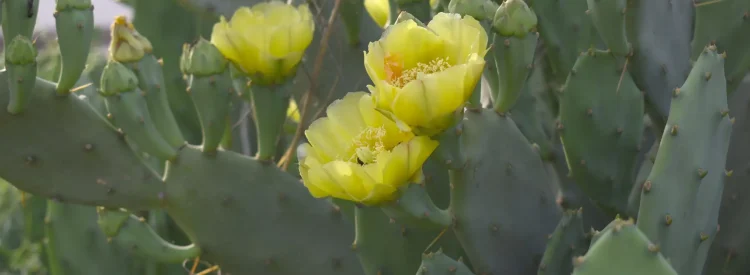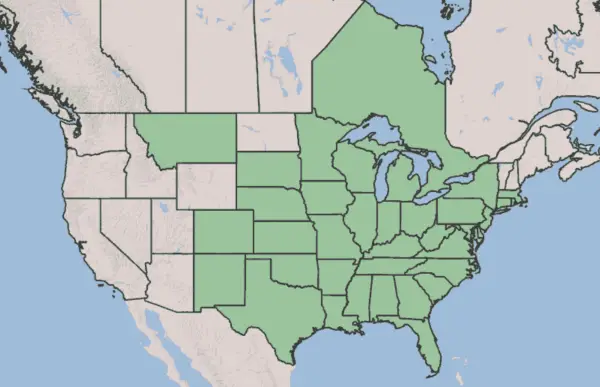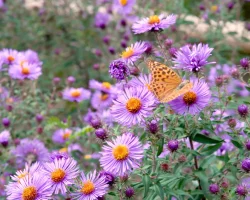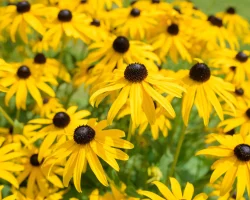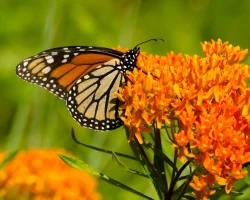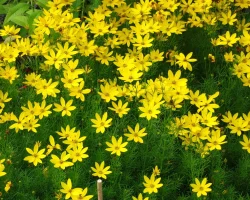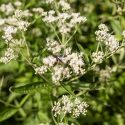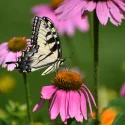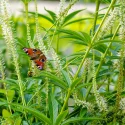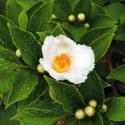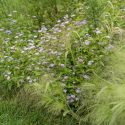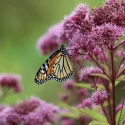Eastern prickly pear is the native cactus that proves you don’t need to live in the desert to grow one. It thrives in poor, sandy soil and full sun—places most other plants would give up. In the summer, its paddle-like pads sprout showy yellow blooms, followed by red fruits beloved by wildlife (and edible for you, too). Low-growing and sculptural, it’s a perfect choice for slopes, borders, or hot, dry spots where nothing else seems to work.
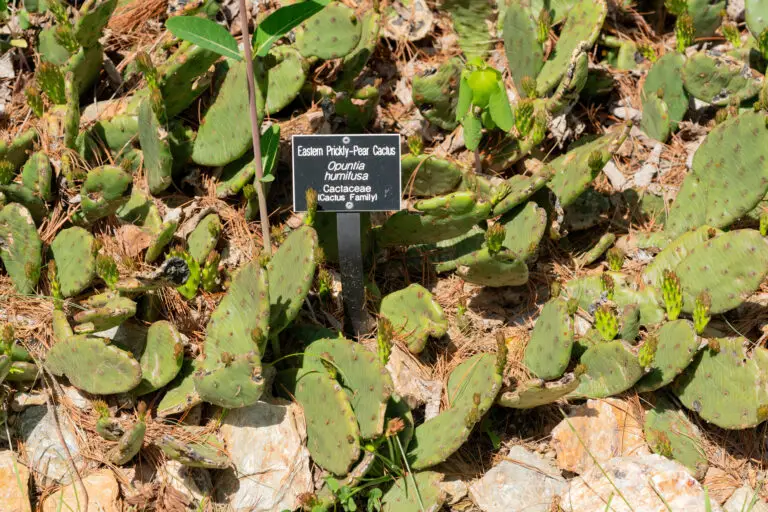
Is eastern prickly pear a good choice for my yard?
Yes, if…
- You have full sun. Prickly pear needs bright light and heat to thrive—it won’t bloom in shade.
- Your soil drains quickly. Sandy, rocky, or gravelly spots are perfect. (If puddles stick around after rain, pick another plant.)
- You want to stop watering. Once established, it thrives entirely on normal rainfall.
- You love pollinators and wildlife. Bees visit the flowers, and birds snack on the fruit.
- You like low-maintenance plants with personality. It’s architectural, resilient, and requires zero fuss.
Not ideal if you want something soft to brush past on a walkway—those tiny spines mean “look, don’t touch.”
Why eastern pricky pear matters
Planting native species like eastern prickly pear does more than add visual drama and surprise—it supports the local ecosystem and simplifies your gardening routine.
Some benefits of planting Eastern prickly pear cactus include:
- Built for tough sites. Thrives in sandy, rocky, or poor soil where most plants won’t grow.
- Pollinator power. Bright yellow flowers attract native bees and butterflies.
- Low-maintenance beauty. Needs no watering once established and shrugs off drought and heat.
- Wildlife support. Birds and small mammals eat its fruit, while its pads offer shelter.
New to native?
Before lawns and landscaping, native plants were here. They’ve fed birds, bees, and butterflies for thousands of years—and they’ll do the same in your yard. The best part? They’re easier to grow than you think.
How to grow eastern prickly pear cactus
Plant your prickly pear in full sun and well-drained soil—the sandier, the better. It doesn’t need fertilizer or special care. Once established, it’s fully drought-tolerant and won’t need watering.
If your soil holds water, plant it on a slope or raised bed to prevent rot. Pads can be easily propagated: cut a pad, let it dry for a few days, then place it in soil where it will quickly root.
Pro tip: Wear gloves when handling—those spikes are no joke.
This cactus can take the cold
Despite being a cactus, Eastern prickly pear is one of the most cold-hardy species in the world. It can survive temperatures as low as –30°F, thanks to a special ability to dehydrate itself in winter, preventing its cells from freezing. It’s found as far north as Ontario, Canada.
Where is eastern prickly pear native?
This cactus is native to half of North America, from Ontario to Florida.
Yep. This plant can thrive in the frozen winters of Ontario, and also live happily in the swampy humidity of the southeast.
This range is ENORMOUS. You can imagine that an eastern prickly pear from New York is going to have vastly different DNA than a plant with DNA from Texas. Because of this, we have a tip…
Plants and seeds grown close to home are tuned to your soil, weather, and pollinators. Stay within 500 miles—or about a day’s drive—to help your garden thrive naturally.
Where eastern prickly pear shines in your yard
This cactus loves sunny, dry spots—the ones that bake all summer and seem impossible to plant. Use it on slopes, in rock gardens, or along walkways where you want something textural and unexpected. It’s also perfect for pollinator gardens, xeriscapes, and coastal landscapes where salt and sand are part of the deal.
Where can I find eastern prickly pear?
We are not going to lie and say that finding this native cactus is going to be as simple as driving to your closest plant nursery. It might take a little extra energy to find this native gem, but it is worth it! Here are some recommendations for sourcing this native plant:
Where can I find seeds and plants?
Finding native plants can be challenging (we partly blame Marie Antoinette.) To make it easier, we’ve assembled four sourcing ideas.
300+ native nurseries make finding one a breeze
Explore 100+ native-friendly eCommerce sites
Every state and province has a native plant society; find yours
Online Communities
Local Facebook groups are a great plant source
What are good pairings for eastern prickly pear?
Pair with other natives that love full fun and good drainage. Some stellar ideas include:
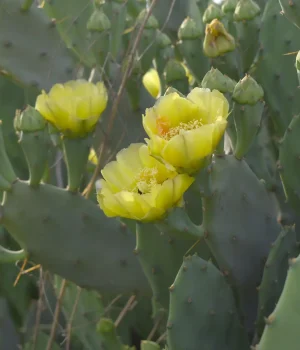
Pairs well with
Eastern prickly pear is proof that native plants can be both rugged and beautiful. It thrives in tough spots, needs almost no care, and rewards you with luminous yellow blooms and sculptural charm. Plant a few in the sunniest, driest corner of your yard, and watch it transform into a pollinator hotspot that looks straight out of the desert—no watering can required. Looking to explore some other sculpturally stunning native plants? Head over to our Beginner’s Guide to Native Irises, or our Beginner’s Guide to Rattlesnake Master. (Yes, you read that right!) Happy planting!
Sources
- Wiley, Deb. “Growing Cactus Plants in Cold Climates.” Better Homes & Gardens, last updated July 12, 2022. https://www.bhg.com/gardening/flowers/perennials/growing-cactus-plants-in-cold-climates.
- USDA Plants Database, Usda.gov. 2025. https://plants.usda.gov/plant-profile/OPHU.
What if your feed was actually good for your mental health?
Give your algorithm a breath of fresh air and follow us.
